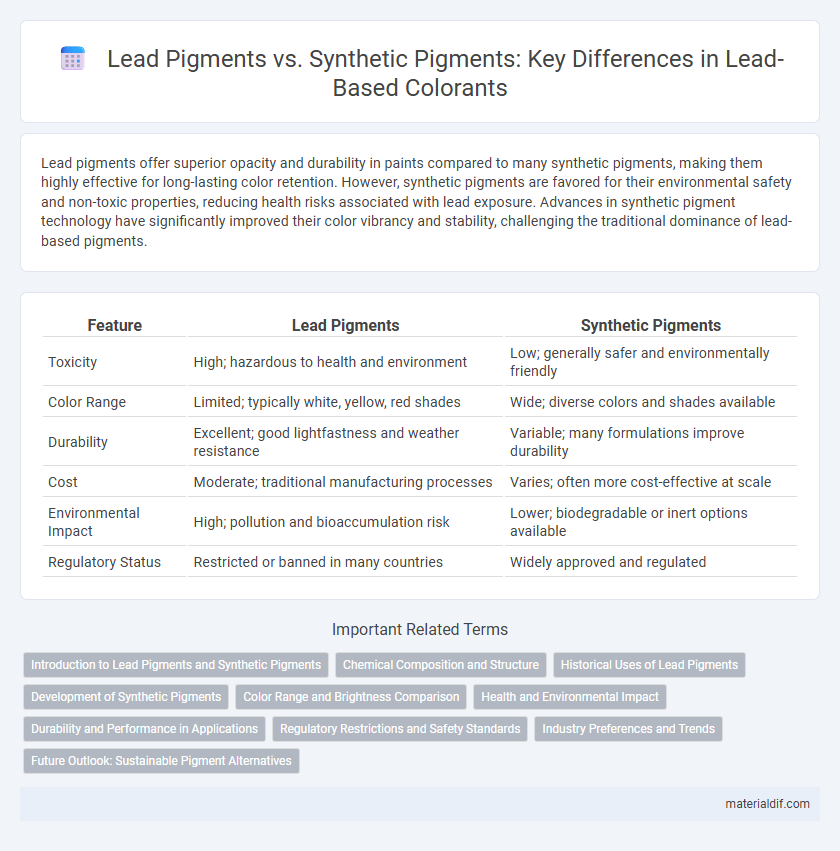Lead pigments offer superior opacity and durability in paints compared to many synthetic pigments, making them highly effective for long-lasting color retention. However, synthetic pigments are favored for their environmental safety and non-toxic properties, reducing health risks associated with lead exposure. Advances in synthetic pigment technology have significantly improved their color vibrancy and stability, challenging the traditional dominance of lead-based pigments.
Table of Comparison
| Feature | Lead Pigments | Synthetic Pigments |
|---|---|---|
| Toxicity | High; hazardous to health and environment | Low; generally safer and environmentally friendly |
| Color Range | Limited; typically white, yellow, red shades | Wide; diverse colors and shades available |
| Durability | Excellent; good lightfastness and weather resistance | Variable; many formulations improve durability |
| Cost | Moderate; traditional manufacturing processes | Varies; often more cost-effective at scale |
| Environmental Impact | High; pollution and bioaccumulation risk | Lower; biodegradable or inert options available |
| Regulatory Status | Restricted or banned in many countries | Widely approved and regulated |
Introduction to Lead Pigments and Synthetic Pigments
Lead pigments, historically valued for their excellent opacity, durability, and bright white color, consist primarily of lead carbonate and lead chromate compounds used in paints and coatings. Synthetic pigments, developed through chemical synthesis, offer a broad spectrum of colors with enhanced stability, non-toxicity, and environmental safety compared to traditional lead-based pigments. The shift from lead pigments to synthetic alternatives reflects advancements in pigment technology focused on health regulations and sustainable applications.
Chemical Composition and Structure
Lead pigments primarily consist of lead-based compounds such as lead carbonate (PbCO3) and lead chromate (PbCrO4), featuring a dense crystalline lattice that imparts high opacity and durability. Synthetic pigments typically comprise organic or inorganic compounds engineered at the molecular level to achieve specific colors, with structures varying from complex aromatic rings in organic pigments to finely controlled crystal systems in inorganic variants. The unique chemical composition and molecular arrangement in lead pigments contribute to their superior coverage and resistance, contrasting with the tailored structural diversity found in synthetic pigments designed for a broader application range.
Historical Uses of Lead Pigments
Lead pigments have been historically valued for their opacity and vibrant white color, prominently featured in Renaissance paintings and ancient frescoes. Their durability and fast drying properties made lead-based compounds like lead white a standard in oil painting and cosmetics for centuries. Despite their toxicity, lead pigments were widely used until synthetic alternatives such as titanium dioxide and zinc oxide provided safer, more stable options for artists and manufacturers.
Development of Synthetic Pigments
Synthetic pigments have revolutionized the paint and coatings industry by offering enhanced color stability, non-toxicity, and superior durability compared to traditional lead-based pigments. Advances in chemical engineering have enabled the creation of vibrant, environment-friendly alternatives such as titanium dioxide and synthetic organic pigments that outperform lead pigments in opacity and lightfastness. The shift towards synthetic pigments is driven by stringent environmental regulations targeting lead toxicity and the demand for sustainable, safer materials in manufacturing and consumer products.
Color Range and Brightness Comparison
Lead pigments offer a limited color range primarily in whites and yellows but deliver exceptional brightness and opacity due to their high refractive index. Synthetic pigments provide a broader and more diverse color palette, including vibrant reds, blues, and greens, though they often lack the intense brightness that lead-based pigments naturally possess. Advances in synthetic pigment technology continue to narrow the brightness gap while maintaining superior safety and environmental profiles compared to traditional lead pigments.
Health and Environmental Impact
Lead pigments, historically used for their vibrant color and durability, pose significant health hazards including neurotoxicity and developmental delays, especially in children. Synthetic pigments, often engineered to be less toxic, offer safer alternatives with reduced environmental contamination during production and disposal. However, some synthetic pigments may still involve harmful chemical processes, highlighting the need for careful material selection and regulation to minimize ecological and human health risks.
Durability and Performance in Applications
Lead pigments exhibit superior durability and colorfastness in applications such as paints and coatings, resisting moisture and UV degradation better than many synthetic pigments. Their high opacity and excellent adhesion contribute to long-lasting performance, especially in industrial and marine environments. Synthetic pigments, while safer and more environmentally friendly, often require additives to match the robustness and longevity provided by lead-based pigments.
Regulatory Restrictions and Safety Standards
Lead pigments face stringent regulatory restrictions due to their toxic properties, with many countries enforcing bans or severe limitations on their use in consumer products, especially paints and coatings. Synthetic pigments, often composed of organic or non-toxic inorganic compounds, comply with modern safety standards and are preferred for applications requiring lower health risks. Regulatory agencies such as the EPA and REACH emphasize the reduction of lead-based pigments to minimize environmental contamination and adverse health effects.
Industry Preferences and Trends
Lead pigments, historically favored for their durability and opacity, are increasingly replaced by synthetic pigments due to environmental regulations and health concerns. The industry trend shows a strong preference for synthetic pigments, such as titanium dioxide and organic alternatives, which offer improved safety profiles and enhanced color stability. Manufacturers prioritize these synthetic options to meet sustainability goals and comply with stringent global standards.
Future Outlook: Sustainable Pigment Alternatives
Lead pigments, historically valued for their vibrant colors and durability, face decreasing usage due to toxicity concerns and stringent environmental regulations. Synthetic pigments, including organic and inorganic variants, offer sustainable alternatives with lower environmental impact and improved safety profiles. Advances in bio-based and nano-engineered pigments promise enhanced performance and eco-friendliness, driving future development towards sustainable coloration solutions in paints and coatings.
Lead pigments vs Synthetic pigments Infographic

 materialdif.com
materialdif.com